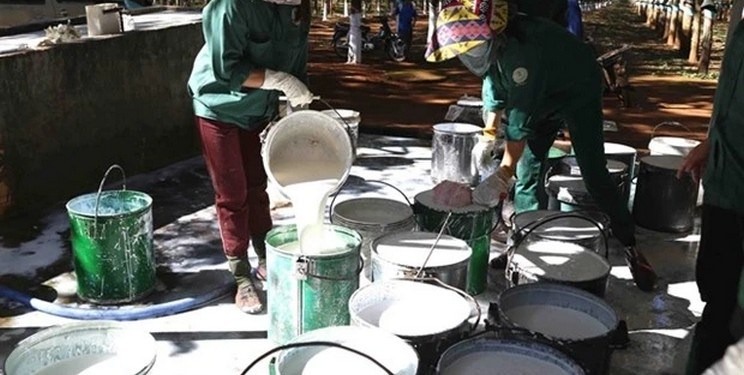Introduction: In Q3, China’s NR latex prices gradually climbed from a low level, reaching a high point for the year. The main reason for this trend was that the supply of natural rubber in Q3 underperformed, and China’s domestic spot resources remained tight for a long time. In addition, due to factors such as typhoons, the feedstock production in the producing areas was not as good as the seasonal performance, which gradually increased the NR latex price. At the end of September, with the improvement of the macroeconomic atmosphere, NR latex prices rose to the highest point of the year.
NR latex prices fell after rushing up amid the underperformed supply.
Affected by factors such as poor demand and limited import profits, the supply in China’s domestic NR latex market remained tight in Q3 for a long time. Although the overall market supply ramped up in July due to seasonal factors, China’s domestic demand was tepid, resulting in strong supply and weak demand, which was bearish for NR latex prices. However, at the end of August, due to the low output of field latex in Thailand, coupled with the appreciation of the Thai baht against the US dollar during the month, the cost side boosted the USD price to rise. At the same time, the arrivals of imported goods at the port were insufficient, and futures prices went up. Therefore, the RMB price of NR latex mounted up. Entering September, on the one hand, due to the influence of typhoon weather, feedstock production was obstructed in both domestic and foreign producing areas. Among them, production in Hainan was stagnant for a time, resulting in a significant increase in the price of field latex. On the other hand, at the end of September, with the introduction of a number of important policy measures by the central bank, a series of monetary policies provided strong support for the commodity market, and the overall macro performance was favorable, which bolstered the price of NR latex to rally again, setting the highest price point of the year in the domestic RMB market. The price of NR latex Thailand TVR in bulk reached RMB 15,100/mt.
Supply: China’s domestic import volume remained low as the production in producing areas was not as good as seasonal performance.
Entering Q3, the natural rubber ushered in the traditional production peak season, and the supply was expected to grow, bearing down on the price. However, overall, there was still more rainfall in China’s domestic and foreign producing areas in Q3, especially in September. Due to the successive impact of typhoon and tropical storm on the producing areas, not only did the production in Hainan stagnate, but the continuous rainfall brought by the typhoon also caused floods in North Thailand and Northeast Thailand, and rubber tapping and transportation were blocked. Affected by this, the price of feedstock continued to rise due to unsmooth supply. As of the end of September, the purchase price of field latex in Thailand was THB 78/kg, up 41% from the beginning of the year; the purchase price of cup lump was THB 59.95/kg, up 29.9% from the beginning of the year, both at the historical high level for the same period. The continued high price of feedstock in Thailand pushed up the USD price of NR latex, but the underperformed demand in China’s domestic market made the enthusiasm for purchasing USD-denominated cargo poor, and also put pressure on the rise of the RMB price. Affected by this, the prices of NR latex in China’s domestic market were lower than those in the foreign market in Q3, frustrating traders’ import intentions. China’s total NR latex import volume in July 2024 was 19kt, down 14.63% MoM but down 42.76% YoY. The import volume of NR latex in August was 25.8kt, up 35.69% MoM but down 42.76% YoY, both maintaining the lowest monthly import volume in the past five years.
Demand: Cost pressure gradually mounted up, and downstream plants’ operation was lukewarm.
In Q3, with the continued increment in China’s domestic NR latex prices, the cost pressure on downstream plants moved up, causing the processing profits of some downstream plants to be negative, especially in September. Taking the downstream foaming industry, its orders did not improve, but the cost continuously swung up, so some enterprises further reduced their operating rates at the end of September, and even some enterprises stopped production. At the same time, although the balloon industry improved somewhat in Q3 affected by seasonal factors, many downstream fields, including the latex glove industry, lacked obvious improvement. Therefore, with the increasing cost pressure, downstream plants were cautious about purchasing high-priced feedstock, dragging down the demand for NR latex.
In Q4, 2024, it is suggested to pay attention to changes in supply in producing areas.
On the whole, the current “Golden September and Silver October” has not strongly boosted the downstream market. On the contrary, due to cost pressure, the purchasing demand from downstream plants is relatively weak. The prices of finished products of some plants have increased in October, and the overall order sales lack a clear trend of improvement. Q4 is also the traditional peak season for natural rubber supply. If the climate is normal, the current high price of feedstock may stimulate the enthusiasm of rubber farmers to tap rubber, and the feedstock output will achieve a significant increment, which will put pressure on the market. For this reason, with the release of supply pressure and the lack of improvement on the demand side, the imbalance between supply and demand may gradually expand, bearing down on rubber prices. However, changes in supply in producing areas still need to be continuously focused on due to the aging of the rubber tree age structure in South Thailand and the possibility of abnormal climate disturbances and other abnormal conditions reappearing.
























